Legal Regulation of Business Structure
VerifiedAdded on 2023/01/03
|10
|3041
|92
AI Summary
This document discusses the legal regulations surrounding business structures, focusing on two case scenarios. In the first scenario, the constitution amendments of AMAZE Ltd are analyzed for their validity. In the second scenario, the liabilities of Kitty and Poppy in relation to contracts with Commercial Cafe Ltd and Tom are examined. The document provides insights into the Corporations Act 2001 and relevant case law.
Contribute Materials
Your contribution can guide someone’s learning journey. Share your
documents today.
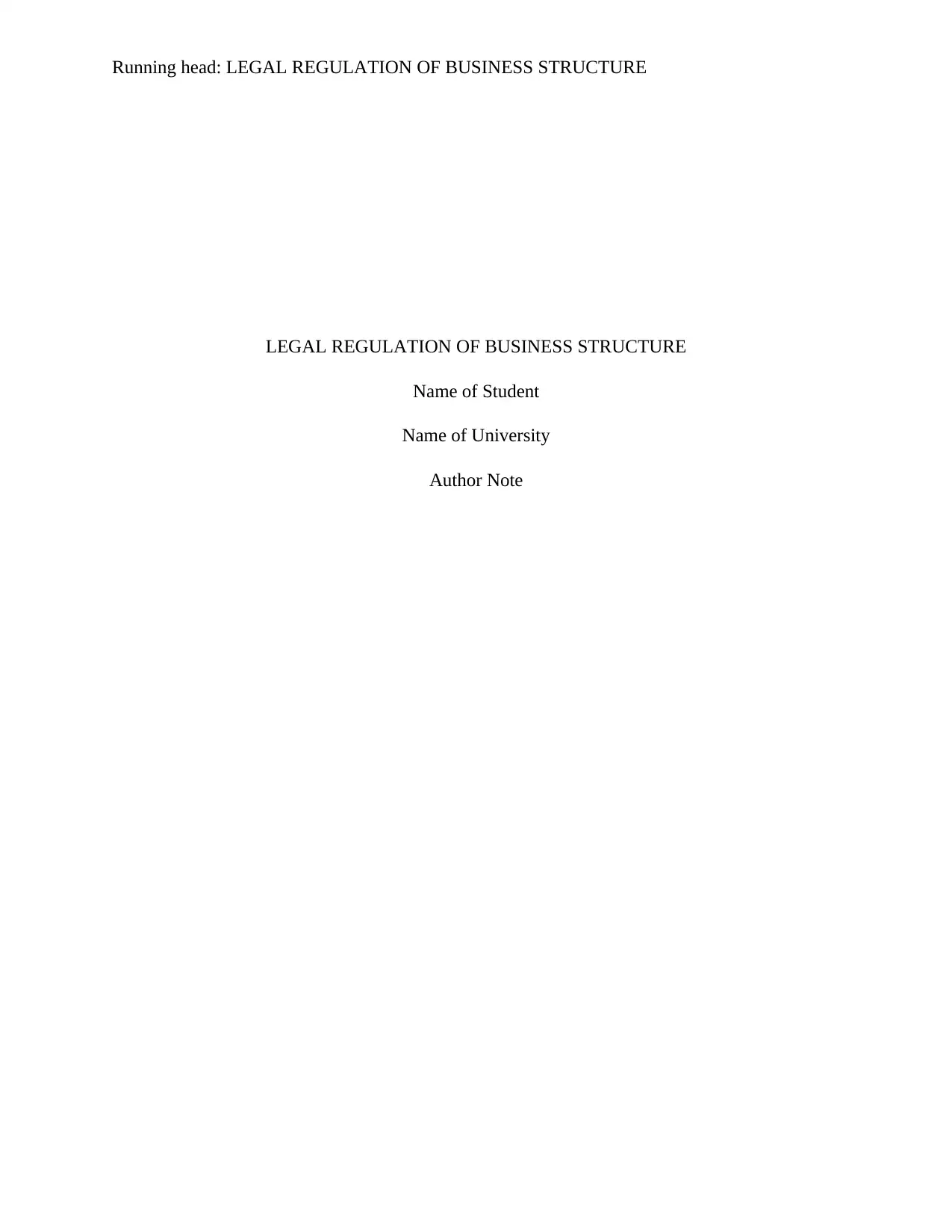
Running head: LEGAL REGULATION OF BUSINESS STRUCTURE
LEGAL REGULATION OF BUSINESS STRUCTURE
Name of Student
Name of University
Author Note
LEGAL REGULATION OF BUSINESS STRUCTURE
Name of Student
Name of University
Author Note
Secure Best Marks with AI Grader
Need help grading? Try our AI Grader for instant feedback on your assignments.
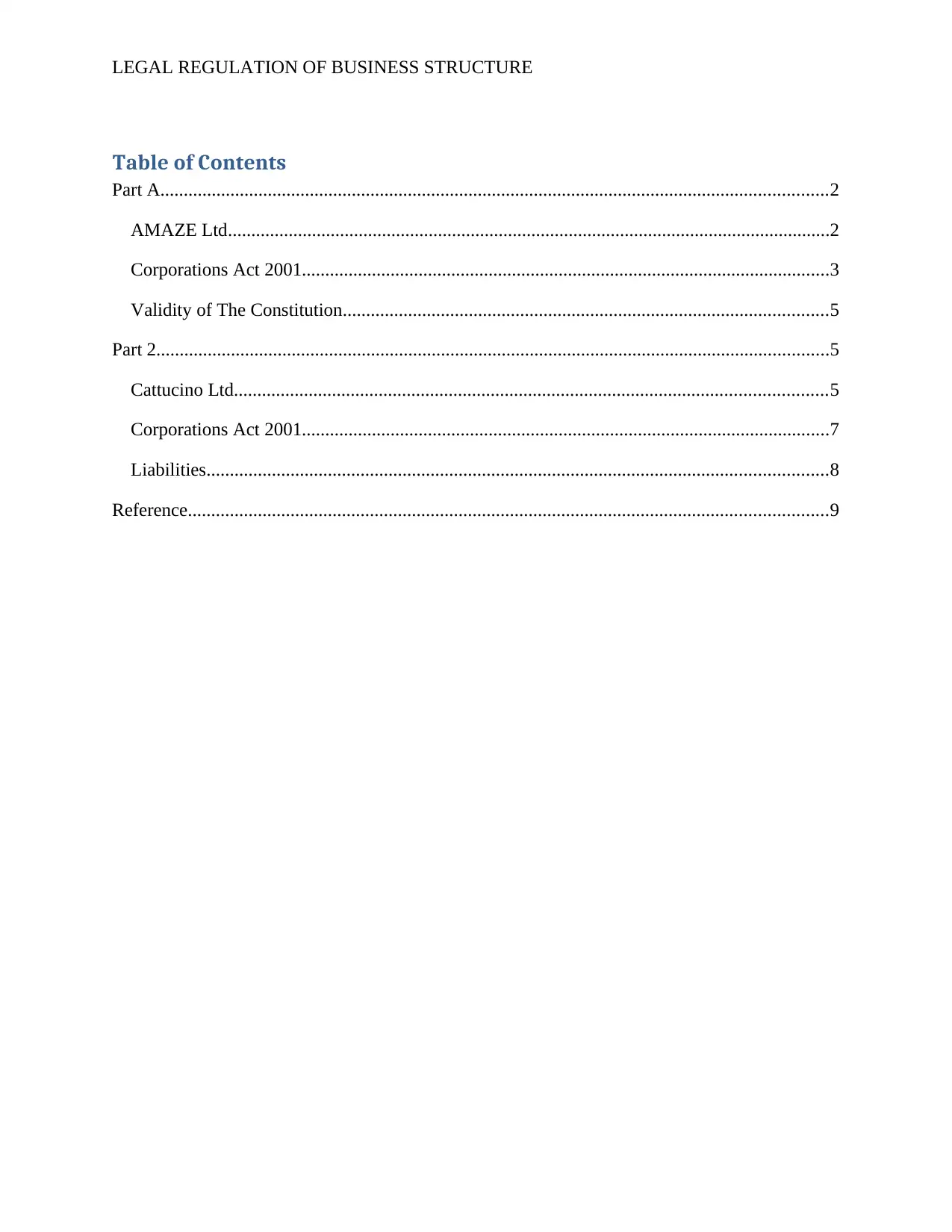
LEGAL REGULATION OF BUSINESS STRUCTURE
Table of Contents
Part A...............................................................................................................................................2
AMAZE Ltd.................................................................................................................................2
Corporations Act 2001.................................................................................................................3
Validity of The Constitution........................................................................................................5
Part 2................................................................................................................................................5
Cattucino Ltd...............................................................................................................................5
Corporations Act 2001.................................................................................................................7
Liabilities.....................................................................................................................................8
Reference.........................................................................................................................................9
Table of Contents
Part A...............................................................................................................................................2
AMAZE Ltd.................................................................................................................................2
Corporations Act 2001.................................................................................................................3
Validity of The Constitution........................................................................................................5
Part 2................................................................................................................................................5
Cattucino Ltd...............................................................................................................................5
Corporations Act 2001.................................................................................................................7
Liabilities.....................................................................................................................................8
Reference.........................................................................................................................................9
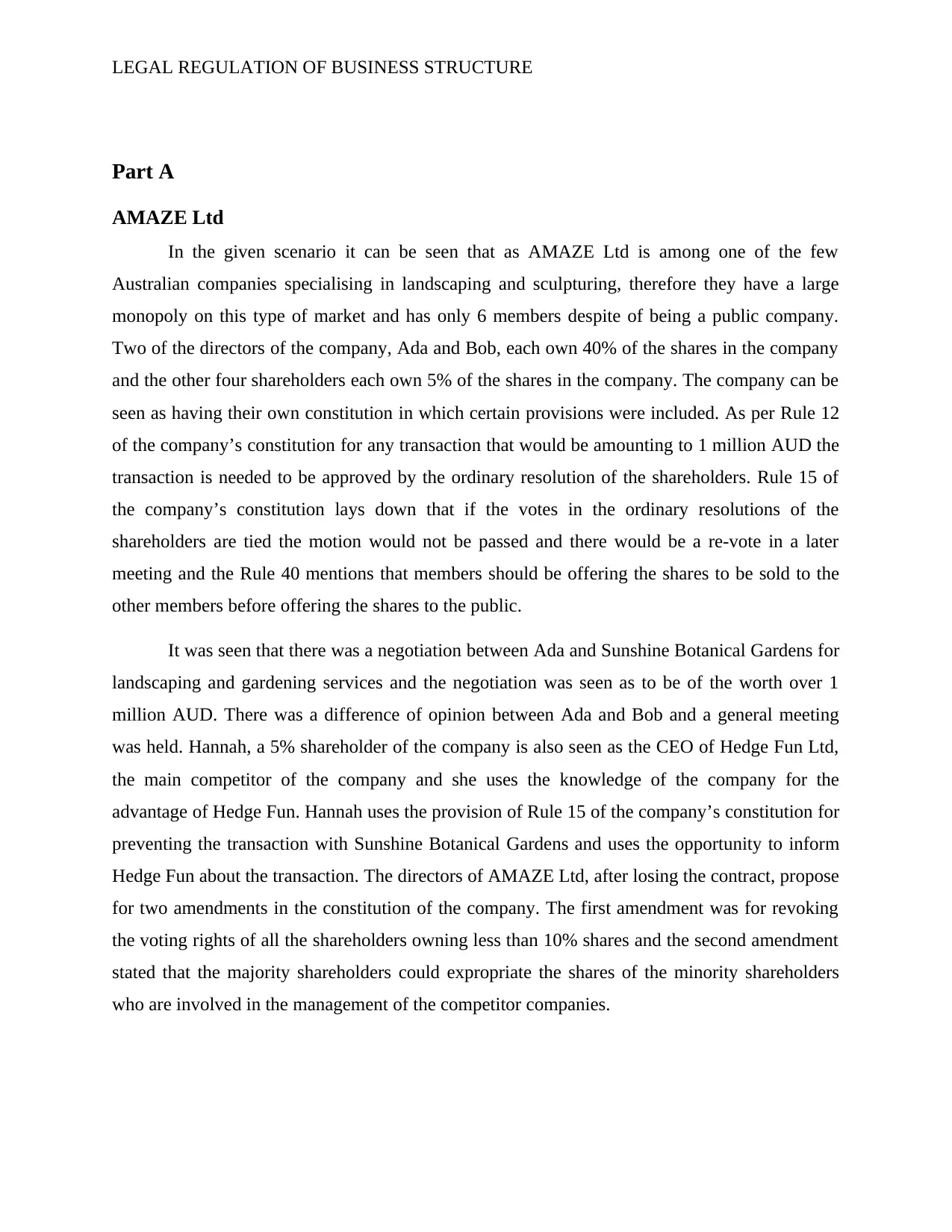
LEGAL REGULATION OF BUSINESS STRUCTURE
Part A
AMAZE Ltd
In the given scenario it can be seen that as AMAZE Ltd is among one of the few
Australian companies specialising in landscaping and sculpturing, therefore they have a large
monopoly on this type of market and has only 6 members despite of being a public company.
Two of the directors of the company, Ada and Bob, each own 40% of the shares in the company
and the other four shareholders each own 5% of the shares in the company. The company can be
seen as having their own constitution in which certain provisions were included. As per Rule 12
of the company’s constitution for any transaction that would be amounting to 1 million AUD the
transaction is needed to be approved by the ordinary resolution of the shareholders. Rule 15 of
the company’s constitution lays down that if the votes in the ordinary resolutions of the
shareholders are tied the motion would not be passed and there would be a re-vote in a later
meeting and the Rule 40 mentions that members should be offering the shares to be sold to the
other members before offering the shares to the public.
It was seen that there was a negotiation between Ada and Sunshine Botanical Gardens for
landscaping and gardening services and the negotiation was seen as to be of the worth over 1
million AUD. There was a difference of opinion between Ada and Bob and a general meeting
was held. Hannah, a 5% shareholder of the company is also seen as the CEO of Hedge Fun Ltd,
the main competitor of the company and she uses the knowledge of the company for the
advantage of Hedge Fun. Hannah uses the provision of Rule 15 of the company’s constitution for
preventing the transaction with Sunshine Botanical Gardens and uses the opportunity to inform
Hedge Fun about the transaction. The directors of AMAZE Ltd, after losing the contract, propose
for two amendments in the constitution of the company. The first amendment was for revoking
the voting rights of all the shareholders owning less than 10% shares and the second amendment
stated that the majority shareholders could expropriate the shares of the minority shareholders
who are involved in the management of the competitor companies.
Part A
AMAZE Ltd
In the given scenario it can be seen that as AMAZE Ltd is among one of the few
Australian companies specialising in landscaping and sculpturing, therefore they have a large
monopoly on this type of market and has only 6 members despite of being a public company.
Two of the directors of the company, Ada and Bob, each own 40% of the shares in the company
and the other four shareholders each own 5% of the shares in the company. The company can be
seen as having their own constitution in which certain provisions were included. As per Rule 12
of the company’s constitution for any transaction that would be amounting to 1 million AUD the
transaction is needed to be approved by the ordinary resolution of the shareholders. Rule 15 of
the company’s constitution lays down that if the votes in the ordinary resolutions of the
shareholders are tied the motion would not be passed and there would be a re-vote in a later
meeting and the Rule 40 mentions that members should be offering the shares to be sold to the
other members before offering the shares to the public.
It was seen that there was a negotiation between Ada and Sunshine Botanical Gardens for
landscaping and gardening services and the negotiation was seen as to be of the worth over 1
million AUD. There was a difference of opinion between Ada and Bob and a general meeting
was held. Hannah, a 5% shareholder of the company is also seen as the CEO of Hedge Fun Ltd,
the main competitor of the company and she uses the knowledge of the company for the
advantage of Hedge Fun. Hannah uses the provision of Rule 15 of the company’s constitution for
preventing the transaction with Sunshine Botanical Gardens and uses the opportunity to inform
Hedge Fun about the transaction. The directors of AMAZE Ltd, after losing the contract, propose
for two amendments in the constitution of the company. The first amendment was for revoking
the voting rights of all the shareholders owning less than 10% shares and the second amendment
stated that the majority shareholders could expropriate the shares of the minority shareholders
who are involved in the management of the competitor companies.
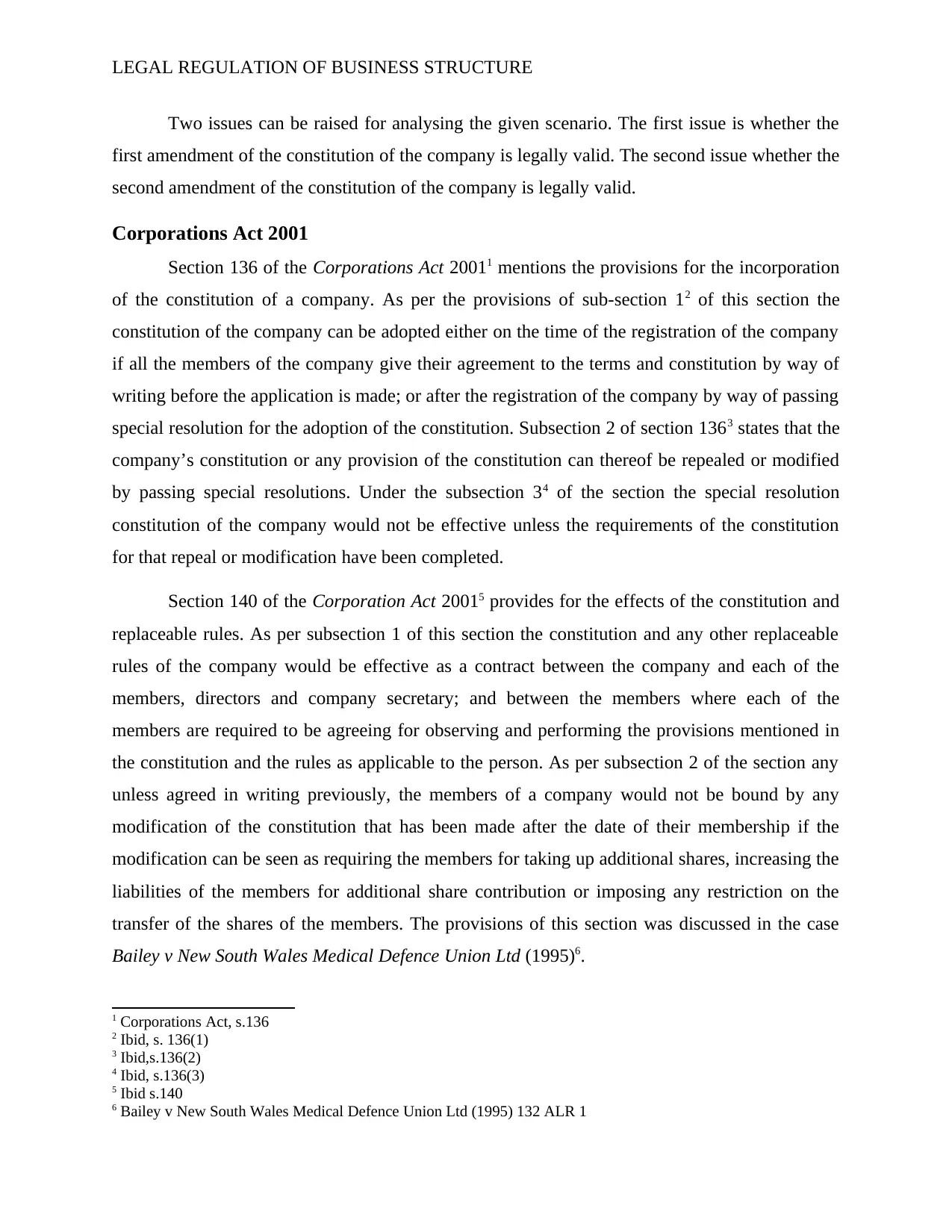
LEGAL REGULATION OF BUSINESS STRUCTURE
Two issues can be raised for analysing the given scenario. The first issue is whether the
first amendment of the constitution of the company is legally valid. The second issue whether the
second amendment of the constitution of the company is legally valid.
Corporations Act 2001
Section 136 of the Corporations Act 20011 mentions the provisions for the incorporation
of the constitution of a company. As per the provisions of sub-section 12 of this section the
constitution of the company can be adopted either on the time of the registration of the company
if all the members of the company give their agreement to the terms and constitution by way of
writing before the application is made; or after the registration of the company by way of passing
special resolution for the adoption of the constitution. Subsection 2 of section 1363 states that the
company’s constitution or any provision of the constitution can thereof be repealed or modified
by passing special resolutions. Under the subsection 34 of the section the special resolution
constitution of the company would not be effective unless the requirements of the constitution
for that repeal or modification have been completed.
Section 140 of the Corporation Act 20015 provides for the effects of the constitution and
replaceable rules. As per subsection 1 of this section the constitution and any other replaceable
rules of the company would be effective as a contract between the company and each of the
members, directors and company secretary; and between the members where each of the
members are required to be agreeing for observing and performing the provisions mentioned in
the constitution and the rules as applicable to the person. As per subsection 2 of the section any
unless agreed in writing previously, the members of a company would not be bound by any
modification of the constitution that has been made after the date of their membership if the
modification can be seen as requiring the members for taking up additional shares, increasing the
liabilities of the members for additional share contribution or imposing any restriction on the
transfer of the shares of the members. The provisions of this section was discussed in the case
Bailey v New South Wales Medical Defence Union Ltd (1995)6.
1 Corporations Act, s.136
2 Ibid, s. 136(1)
3 Ibid,s.136(2)
4 Ibid, s.136(3)
5 Ibid s.140
6 Bailey v New South Wales Medical Defence Union Ltd (1995) 132 ALR 1
Two issues can be raised for analysing the given scenario. The first issue is whether the
first amendment of the constitution of the company is legally valid. The second issue whether the
second amendment of the constitution of the company is legally valid.
Corporations Act 2001
Section 136 of the Corporations Act 20011 mentions the provisions for the incorporation
of the constitution of a company. As per the provisions of sub-section 12 of this section the
constitution of the company can be adopted either on the time of the registration of the company
if all the members of the company give their agreement to the terms and constitution by way of
writing before the application is made; or after the registration of the company by way of passing
special resolution for the adoption of the constitution. Subsection 2 of section 1363 states that the
company’s constitution or any provision of the constitution can thereof be repealed or modified
by passing special resolutions. Under the subsection 34 of the section the special resolution
constitution of the company would not be effective unless the requirements of the constitution
for that repeal or modification have been completed.
Section 140 of the Corporation Act 20015 provides for the effects of the constitution and
replaceable rules. As per subsection 1 of this section the constitution and any other replaceable
rules of the company would be effective as a contract between the company and each of the
members, directors and company secretary; and between the members where each of the
members are required to be agreeing for observing and performing the provisions mentioned in
the constitution and the rules as applicable to the person. As per subsection 2 of the section any
unless agreed in writing previously, the members of a company would not be bound by any
modification of the constitution that has been made after the date of their membership if the
modification can be seen as requiring the members for taking up additional shares, increasing the
liabilities of the members for additional share contribution or imposing any restriction on the
transfer of the shares of the members. The provisions of this section was discussed in the case
Bailey v New South Wales Medical Defence Union Ltd (1995)6.
1 Corporations Act, s.136
2 Ibid, s. 136(1)
3 Ibid,s.136(2)
4 Ibid, s.136(3)
5 Ibid s.140
6 Bailey v New South Wales Medical Defence Union Ltd (1995) 132 ALR 1
Secure Best Marks with AI Grader
Need help grading? Try our AI Grader for instant feedback on your assignments.
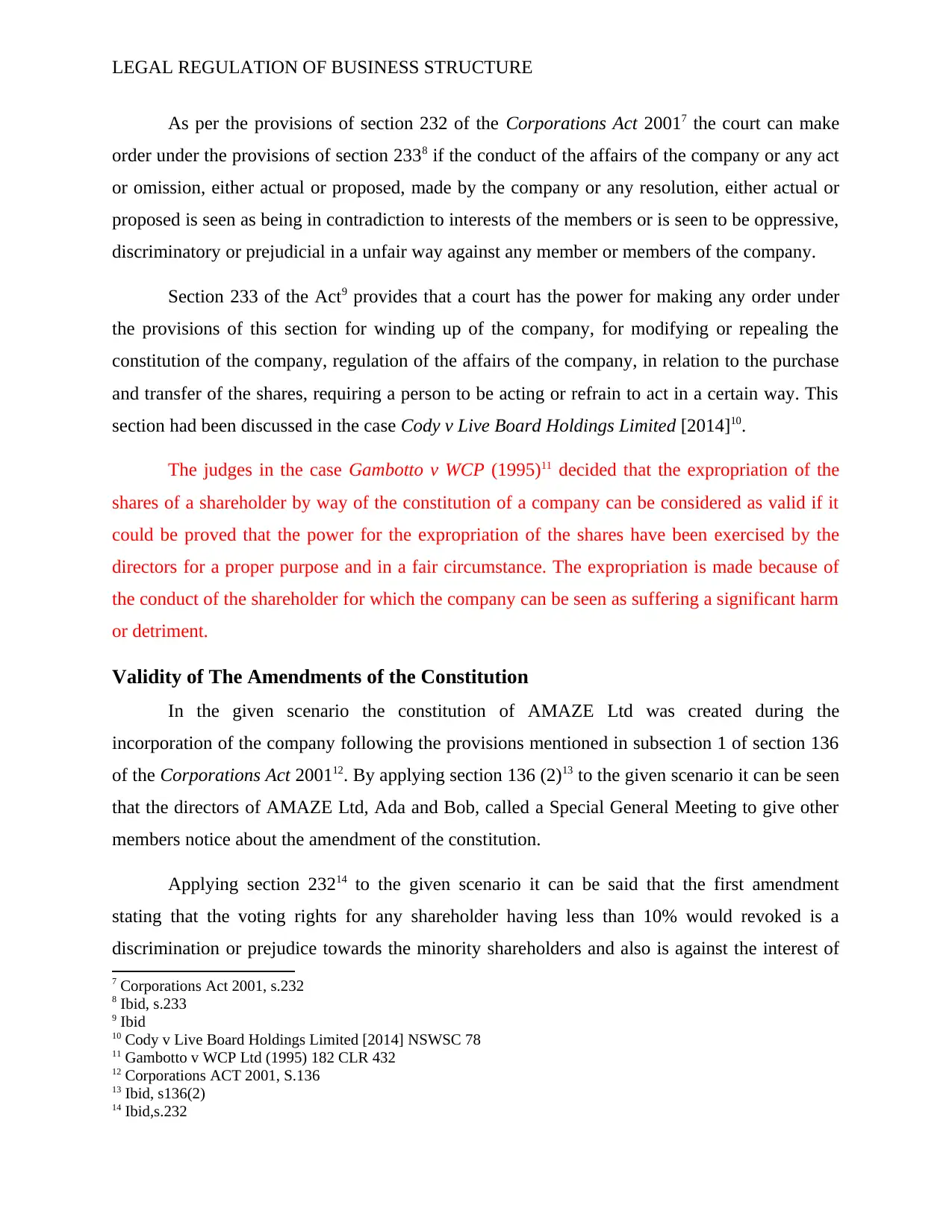
LEGAL REGULATION OF BUSINESS STRUCTURE
As per the provisions of section 232 of the Corporations Act 20017 the court can make
order under the provisions of section 2338 if the conduct of the affairs of the company or any act
or omission, either actual or proposed, made by the company or any resolution, either actual or
proposed is seen as being in contradiction to interests of the members or is seen to be oppressive,
discriminatory or prejudicial in a unfair way against any member or members of the company.
Section 233 of the Act9 provides that a court has the power for making any order under
the provisions of this section for winding up of the company, for modifying or repealing the
constitution of the company, regulation of the affairs of the company, in relation to the purchase
and transfer of the shares, requiring a person to be acting or refrain to act in a certain way. This
section had been discussed in the case Cody v Live Board Holdings Limited [2014]10.
The judges in the case Gambotto v WCP (1995)11 decided that the expropriation of the
shares of a shareholder by way of the constitution of a company can be considered as valid if it
could be proved that the power for the expropriation of the shares have been exercised by the
directors for a proper purpose and in a fair circumstance. The expropriation is made because of
the conduct of the shareholder for which the company can be seen as suffering a significant harm
or detriment.
Validity of The Amendments of the Constitution
In the given scenario the constitution of AMAZE Ltd was created during the
incorporation of the company following the provisions mentioned in subsection 1 of section 136
of the Corporations Act 200112. By applying section 136 (2)13 to the given scenario it can be seen
that the directors of AMAZE Ltd, Ada and Bob, called a Special General Meeting to give other
members notice about the amendment of the constitution.
Applying section 23214 to the given scenario it can be said that the first amendment
stating that the voting rights for any shareholder having less than 10% would revoked is a
discrimination or prejudice towards the minority shareholders and also is against the interest of
7 Corporations Act 2001, s.232
8 Ibid, s.233
9 Ibid
10 Cody v Live Board Holdings Limited [2014] NSWSC 78
11 Gambotto v WCP Ltd (1995) 182 CLR 432
12 Corporations ACT 2001, S.136
13 Ibid, s136(2)
14 Ibid,s.232
As per the provisions of section 232 of the Corporations Act 20017 the court can make
order under the provisions of section 2338 if the conduct of the affairs of the company or any act
or omission, either actual or proposed, made by the company or any resolution, either actual or
proposed is seen as being in contradiction to interests of the members or is seen to be oppressive,
discriminatory or prejudicial in a unfair way against any member or members of the company.
Section 233 of the Act9 provides that a court has the power for making any order under
the provisions of this section for winding up of the company, for modifying or repealing the
constitution of the company, regulation of the affairs of the company, in relation to the purchase
and transfer of the shares, requiring a person to be acting or refrain to act in a certain way. This
section had been discussed in the case Cody v Live Board Holdings Limited [2014]10.
The judges in the case Gambotto v WCP (1995)11 decided that the expropriation of the
shares of a shareholder by way of the constitution of a company can be considered as valid if it
could be proved that the power for the expropriation of the shares have been exercised by the
directors for a proper purpose and in a fair circumstance. The expropriation is made because of
the conduct of the shareholder for which the company can be seen as suffering a significant harm
or detriment.
Validity of The Amendments of the Constitution
In the given scenario the constitution of AMAZE Ltd was created during the
incorporation of the company following the provisions mentioned in subsection 1 of section 136
of the Corporations Act 200112. By applying section 136 (2)13 to the given scenario it can be seen
that the directors of AMAZE Ltd, Ada and Bob, called a Special General Meeting to give other
members notice about the amendment of the constitution.
Applying section 23214 to the given scenario it can be said that the first amendment
stating that the voting rights for any shareholder having less than 10% would revoked is a
discrimination or prejudice towards the minority shareholders and also is against the interest of
7 Corporations Act 2001, s.232
8 Ibid, s.233
9 Ibid
10 Cody v Live Board Holdings Limited [2014] NSWSC 78
11 Gambotto v WCP Ltd (1995) 182 CLR 432
12 Corporations ACT 2001, S.136
13 Ibid, s136(2)
14 Ibid,s.232
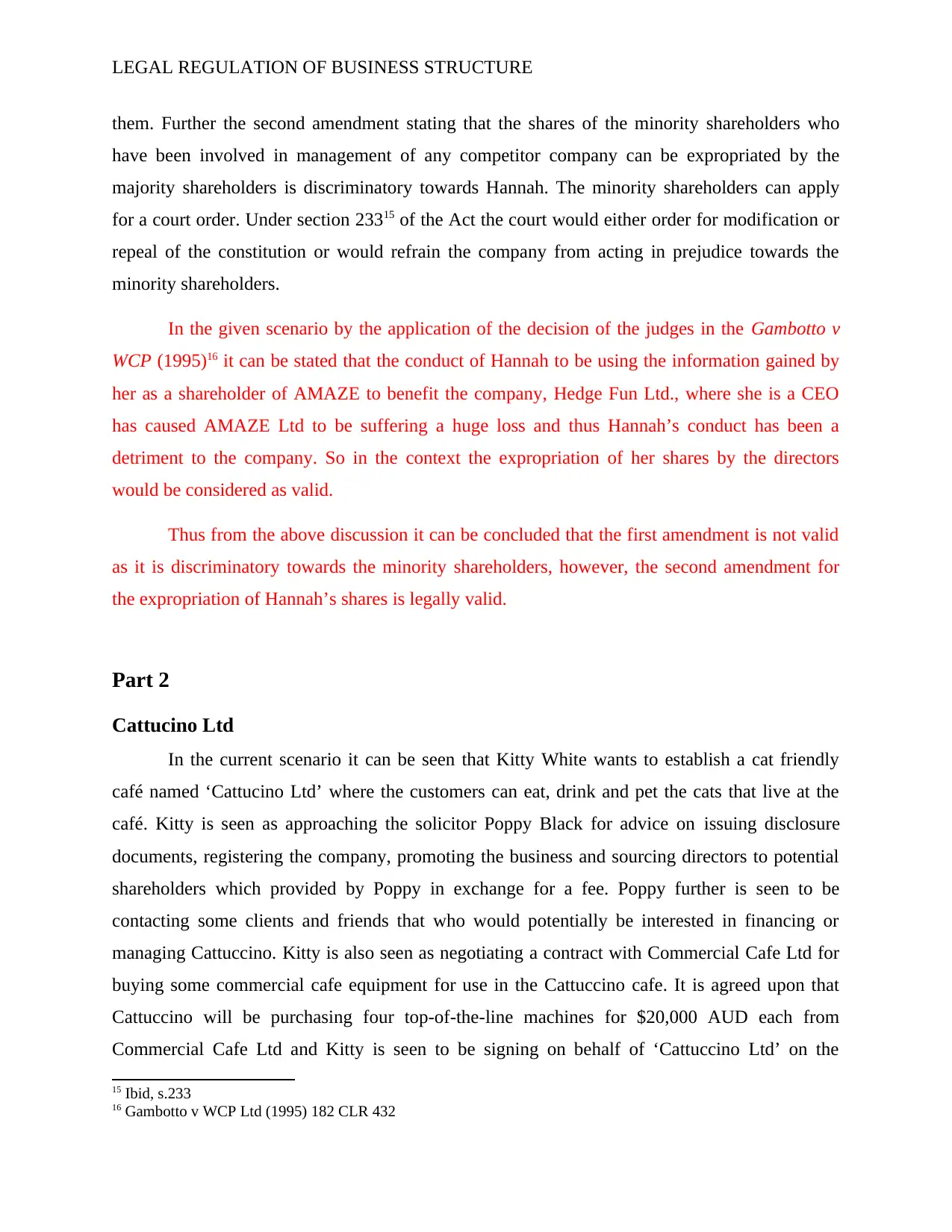
LEGAL REGULATION OF BUSINESS STRUCTURE
them. Further the second amendment stating that the shares of the minority shareholders who
have been involved in management of any competitor company can be expropriated by the
majority shareholders is discriminatory towards Hannah. The minority shareholders can apply
for a court order. Under section 23315 of the Act the court would either order for modification or
repeal of the constitution or would refrain the company from acting in prejudice towards the
minority shareholders.
In the given scenario by the application of the decision of the judges in the Gambotto v
WCP (1995)16 it can be stated that the conduct of Hannah to be using the information gained by
her as a shareholder of AMAZE to benefit the company, Hedge Fun Ltd., where she is a CEO
has caused AMAZE Ltd to be suffering a huge loss and thus Hannah’s conduct has been a
detriment to the company. So in the context the expropriation of her shares by the directors
would be considered as valid.
Thus from the above discussion it can be concluded that the first amendment is not valid
as it is discriminatory towards the minority shareholders, however, the second amendment for
the expropriation of Hannah’s shares is legally valid.
Part 2
Cattucino Ltd
In the current scenario it can be seen that Kitty White wants to establish a cat friendly
café named ‘Cattucino Ltd’ where the customers can eat, drink and pet the cats that live at the
café. Kitty is seen as approaching the solicitor Poppy Black for advice on issuing disclosure
documents, registering the company, promoting the business and sourcing directors to potential
shareholders which provided by Poppy in exchange for a fee. Poppy further is seen to be
contacting some clients and friends that who would potentially be interested in financing or
managing Cattuccino. Kitty is also seen as negotiating a contract with Commercial Cafe Ltd for
buying some commercial cafe equipment for use in the Cattuccino cafe. It is agreed upon that
Cattuccino will be purchasing four top-of-the-line machines for $20,000 AUD each from
Commercial Cafe Ltd and Kitty is seen to be signing on behalf of ‘Cattuccino Ltd’ on the
15 Ibid, s.233
16 Gambotto v WCP Ltd (1995) 182 CLR 432
them. Further the second amendment stating that the shares of the minority shareholders who
have been involved in management of any competitor company can be expropriated by the
majority shareholders is discriminatory towards Hannah. The minority shareholders can apply
for a court order. Under section 23315 of the Act the court would either order for modification or
repeal of the constitution or would refrain the company from acting in prejudice towards the
minority shareholders.
In the given scenario by the application of the decision of the judges in the Gambotto v
WCP (1995)16 it can be stated that the conduct of Hannah to be using the information gained by
her as a shareholder of AMAZE to benefit the company, Hedge Fun Ltd., where she is a CEO
has caused AMAZE Ltd to be suffering a huge loss and thus Hannah’s conduct has been a
detriment to the company. So in the context the expropriation of her shares by the directors
would be considered as valid.
Thus from the above discussion it can be concluded that the first amendment is not valid
as it is discriminatory towards the minority shareholders, however, the second amendment for
the expropriation of Hannah’s shares is legally valid.
Part 2
Cattucino Ltd
In the current scenario it can be seen that Kitty White wants to establish a cat friendly
café named ‘Cattucino Ltd’ where the customers can eat, drink and pet the cats that live at the
café. Kitty is seen as approaching the solicitor Poppy Black for advice on issuing disclosure
documents, registering the company, promoting the business and sourcing directors to potential
shareholders which provided by Poppy in exchange for a fee. Poppy further is seen to be
contacting some clients and friends that who would potentially be interested in financing or
managing Cattuccino. Kitty is also seen as negotiating a contract with Commercial Cafe Ltd for
buying some commercial cafe equipment for use in the Cattuccino cafe. It is agreed upon that
Cattuccino will be purchasing four top-of-the-line machines for $20,000 AUD each from
Commercial Cafe Ltd and Kitty is seen to be signing on behalf of ‘Cattuccino Ltd’ on the
15 Ibid, s.233
16 Gambotto v WCP Ltd (1995) 182 CLR 432
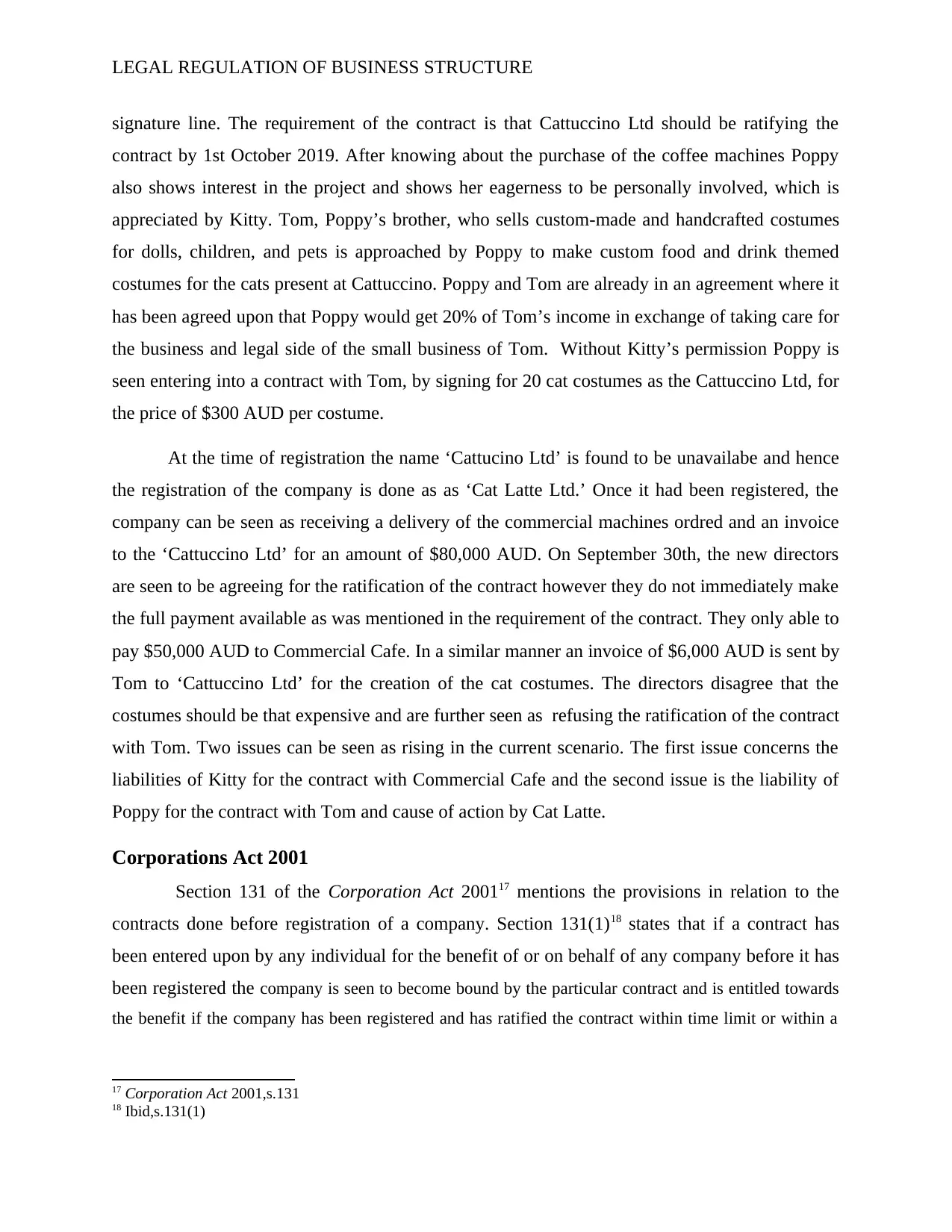
LEGAL REGULATION OF BUSINESS STRUCTURE
signature line. The requirement of the contract is that Cattuccino Ltd should be ratifying the
contract by 1st October 2019. After knowing about the purchase of the coffee machines Poppy
also shows interest in the project and shows her eagerness to be personally involved, which is
appreciated by Kitty. Tom, Poppy’s brother, who sells custom-made and handcrafted costumes
for dolls, children, and pets is approached by Poppy to make custom food and drink themed
costumes for the cats present at Cattuccino. Poppy and Tom are already in an agreement where it
has been agreed upon that Poppy would get 20% of Tom’s income in exchange of taking care for
the business and legal side of the small business of Tom. Without Kitty’s permission Poppy is
seen entering into a contract with Tom, by signing for 20 cat costumes as the Cattuccino Ltd, for
the price of $300 AUD per costume.
At the time of registration the name ‘Cattucino Ltd’ is found to be unavailabe and hence
the registration of the company is done as as ‘Cat Latte Ltd.’ Once it had been registered, the
company can be seen as receiving a delivery of the commercial machines ordred and an invoice
to the ‘Cattuccino Ltd’ for an amount of $80,000 AUD. On September 30th, the new directors
are seen to be agreeing for the ratification of the contract however they do not immediately make
the full payment available as was mentioned in the requirement of the contract. They only able to
pay $50,000 AUD to Commercial Cafe. In a similar manner an invoice of $6,000 AUD is sent by
Tom to ‘Cattuccino Ltd’ for the creation of the cat costumes. The directors disagree that the
costumes should be that expensive and are further seen as refusing the ratification of the contract
with Tom. Two issues can be seen as rising in the current scenario. The first issue concerns the
liabilities of Kitty for the contract with Commercial Cafe and the second issue is the liability of
Poppy for the contract with Tom and cause of action by Cat Latte.
Corporations Act 2001
Section 131 of the Corporation Act 200117 mentions the provisions in relation to the
contracts done before registration of a company. Section 131(1)18 states that if a contract has
been entered upon by any individual for the benefit of or on behalf of any company before it has
been registered the company is seen to become bound by the particular contract and is entitled towards
the benefit if the company has been registered and has ratified the contract within time limit or within a
17 Corporation Act 2001,s.131
18 Ibid,s.131(1)
signature line. The requirement of the contract is that Cattuccino Ltd should be ratifying the
contract by 1st October 2019. After knowing about the purchase of the coffee machines Poppy
also shows interest in the project and shows her eagerness to be personally involved, which is
appreciated by Kitty. Tom, Poppy’s brother, who sells custom-made and handcrafted costumes
for dolls, children, and pets is approached by Poppy to make custom food and drink themed
costumes for the cats present at Cattuccino. Poppy and Tom are already in an agreement where it
has been agreed upon that Poppy would get 20% of Tom’s income in exchange of taking care for
the business and legal side of the small business of Tom. Without Kitty’s permission Poppy is
seen entering into a contract with Tom, by signing for 20 cat costumes as the Cattuccino Ltd, for
the price of $300 AUD per costume.
At the time of registration the name ‘Cattucino Ltd’ is found to be unavailabe and hence
the registration of the company is done as as ‘Cat Latte Ltd.’ Once it had been registered, the
company can be seen as receiving a delivery of the commercial machines ordred and an invoice
to the ‘Cattuccino Ltd’ for an amount of $80,000 AUD. On September 30th, the new directors
are seen to be agreeing for the ratification of the contract however they do not immediately make
the full payment available as was mentioned in the requirement of the contract. They only able to
pay $50,000 AUD to Commercial Cafe. In a similar manner an invoice of $6,000 AUD is sent by
Tom to ‘Cattuccino Ltd’ for the creation of the cat costumes. The directors disagree that the
costumes should be that expensive and are further seen as refusing the ratification of the contract
with Tom. Two issues can be seen as rising in the current scenario. The first issue concerns the
liabilities of Kitty for the contract with Commercial Cafe and the second issue is the liability of
Poppy for the contract with Tom and cause of action by Cat Latte.
Corporations Act 2001
Section 131 of the Corporation Act 200117 mentions the provisions in relation to the
contracts done before registration of a company. Section 131(1)18 states that if a contract has
been entered upon by any individual for the benefit of or on behalf of any company before it has
been registered the company is seen to become bound by the particular contract and is entitled towards
the benefit if the company has been registered and has ratified the contract within time limit or within a
17 Corporation Act 2001,s.131
18 Ibid,s.131(1)
Paraphrase This Document
Need a fresh take? Get an instant paraphrase of this document with our AI Paraphraser
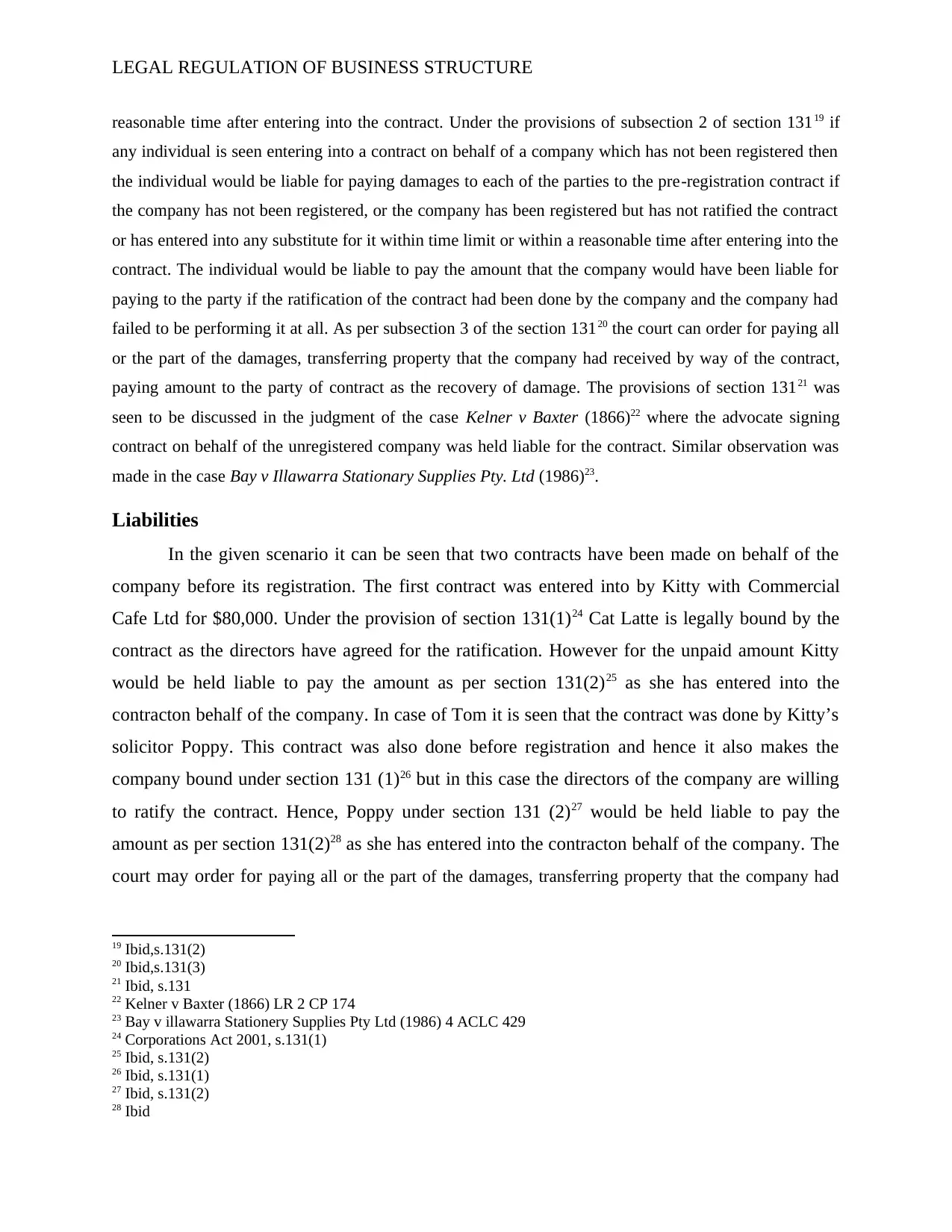
LEGAL REGULATION OF BUSINESS STRUCTURE
reasonable time after entering into the contract. Under the provisions of subsection 2 of section 13119 if
any individual is seen entering into a contract on behalf of a company which has not been registered then
the individual would be liable for paying damages to each of the parties to the pre-registration contract if
the company has not been registered, or the company has been registered but has not ratified the contract
or has entered into any substitute for it within time limit or within a reasonable time after entering into the
contract. The individual would be liable to pay the amount that the company would have been liable for
paying to the party if the ratification of the contract had been done by the company and the company had
failed to be performing it at all. As per subsection 3 of the section 13120 the court can order for paying all
or the part of the damages, transferring property that the company had received by way of the contract,
paying amount to the party of contract as the recovery of damage. The provisions of section 13121 was
seen to be discussed in the judgment of the case Kelner v Baxter (1866)22 where the advocate signing
contract on behalf of the unregistered company was held liable for the contract. Similar observation was
made in the case Bay v Illawarra Stationary Supplies Pty. Ltd (1986)23.
Liabilities
In the given scenario it can be seen that two contracts have been made on behalf of the
company before its registration. The first contract was entered into by Kitty with Commercial
Cafe Ltd for $80,000. Under the provision of section 131(1)24 Cat Latte is legally bound by the
contract as the directors have agreed for the ratification. However for the unpaid amount Kitty
would be held liable to pay the amount as per section 131(2)25 as she has entered into the
contracton behalf of the company. In case of Tom it is seen that the contract was done by Kitty’s
solicitor Poppy. This contract was also done before registration and hence it also makes the
company bound under section 131 (1)26 but in this case the directors of the company are willing
to ratify the contract. Hence, Poppy under section 131 (2)27 would be held liable to pay the
amount as per section 131(2)28 as she has entered into the contracton behalf of the company. The
court may order for paying all or the part of the damages, transferring property that the company had
19 Ibid,s.131(2)
20 Ibid,s.131(3)
21 Ibid, s.131
22 Kelner v Baxter (1866) LR 2 CP 174
23 Bay v illawarra Stationery Supplies Pty Ltd (1986) 4 ACLC 429
24 Corporations Act 2001, s.131(1)
25 Ibid, s.131(2)
26 Ibid, s.131(1)
27 Ibid, s.131(2)
28 Ibid
reasonable time after entering into the contract. Under the provisions of subsection 2 of section 13119 if
any individual is seen entering into a contract on behalf of a company which has not been registered then
the individual would be liable for paying damages to each of the parties to the pre-registration contract if
the company has not been registered, or the company has been registered but has not ratified the contract
or has entered into any substitute for it within time limit or within a reasonable time after entering into the
contract. The individual would be liable to pay the amount that the company would have been liable for
paying to the party if the ratification of the contract had been done by the company and the company had
failed to be performing it at all. As per subsection 3 of the section 13120 the court can order for paying all
or the part of the damages, transferring property that the company had received by way of the contract,
paying amount to the party of contract as the recovery of damage. The provisions of section 13121 was
seen to be discussed in the judgment of the case Kelner v Baxter (1866)22 where the advocate signing
contract on behalf of the unregistered company was held liable for the contract. Similar observation was
made in the case Bay v Illawarra Stationary Supplies Pty. Ltd (1986)23.
Liabilities
In the given scenario it can be seen that two contracts have been made on behalf of the
company before its registration. The first contract was entered into by Kitty with Commercial
Cafe Ltd for $80,000. Under the provision of section 131(1)24 Cat Latte is legally bound by the
contract as the directors have agreed for the ratification. However for the unpaid amount Kitty
would be held liable to pay the amount as per section 131(2)25 as she has entered into the
contracton behalf of the company. In case of Tom it is seen that the contract was done by Kitty’s
solicitor Poppy. This contract was also done before registration and hence it also makes the
company bound under section 131 (1)26 but in this case the directors of the company are willing
to ratify the contract. Hence, Poppy under section 131 (2)27 would be held liable to pay the
amount as per section 131(2)28 as she has entered into the contracton behalf of the company. The
court may order for paying all or the part of the damages, transferring property that the company had
19 Ibid,s.131(2)
20 Ibid,s.131(3)
21 Ibid, s.131
22 Kelner v Baxter (1866) LR 2 CP 174
23 Bay v illawarra Stationery Supplies Pty Ltd (1986) 4 ACLC 429
24 Corporations Act 2001, s.131(1)
25 Ibid, s.131(2)
26 Ibid, s.131(1)
27 Ibid, s.131(2)
28 Ibid
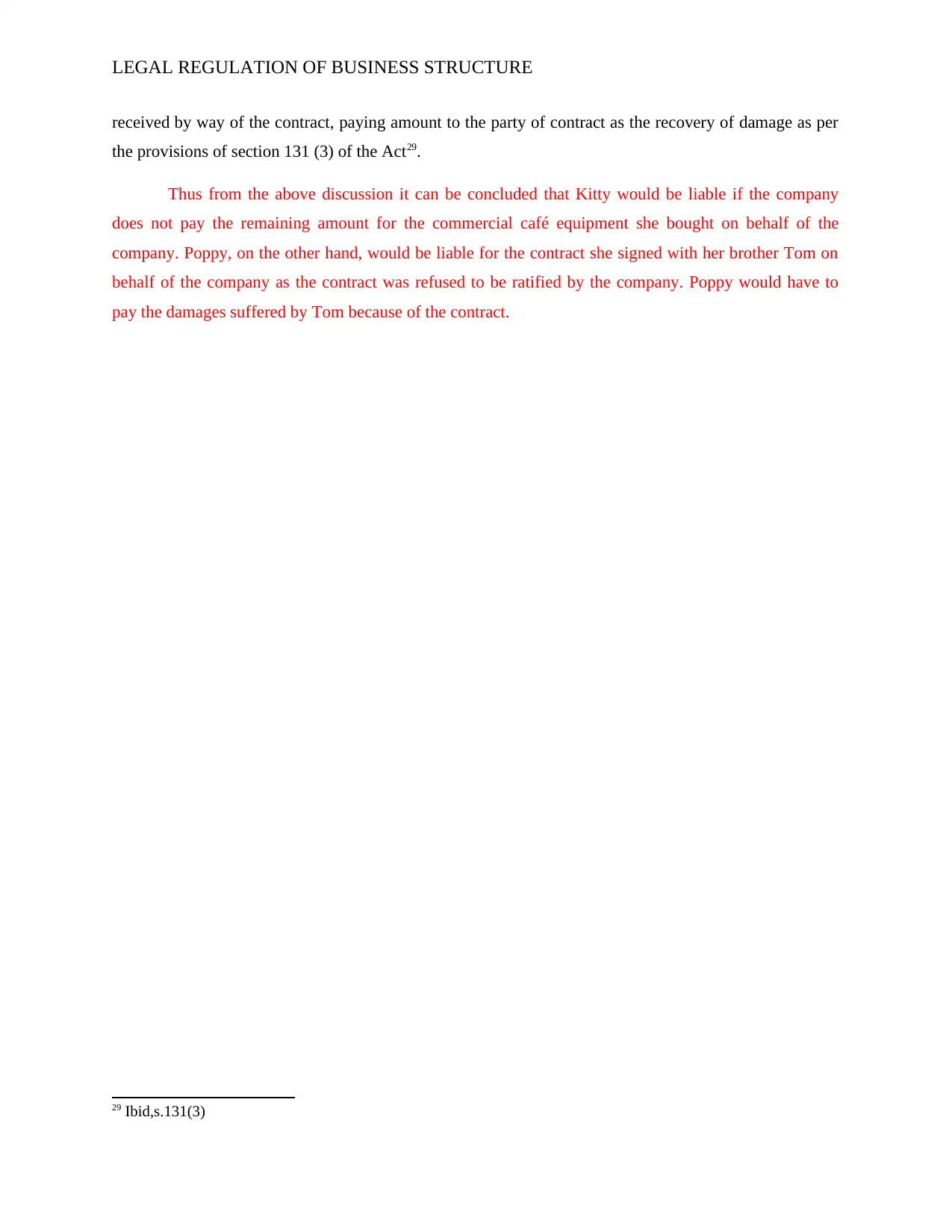
LEGAL REGULATION OF BUSINESS STRUCTURE
received by way of the contract, paying amount to the party of contract as the recovery of damage as per
the provisions of section 131 (3) of the Act29.
Thus from the above discussion it can be concluded that Kitty would be liable if the company
does not pay the remaining amount for the commercial café equipment she bought on behalf of the
company. Poppy, on the other hand, would be liable for the contract she signed with her brother Tom on
behalf of the company as the contract was refused to be ratified by the company. Poppy would have to
pay the damages suffered by Tom because of the contract.
29 Ibid,s.131(3)
received by way of the contract, paying amount to the party of contract as the recovery of damage as per
the provisions of section 131 (3) of the Act29.
Thus from the above discussion it can be concluded that Kitty would be liable if the company
does not pay the remaining amount for the commercial café equipment she bought on behalf of the
company. Poppy, on the other hand, would be liable for the contract she signed with her brother Tom on
behalf of the company as the contract was refused to be ratified by the company. Poppy would have to
pay the damages suffered by Tom because of the contract.
29 Ibid,s.131(3)
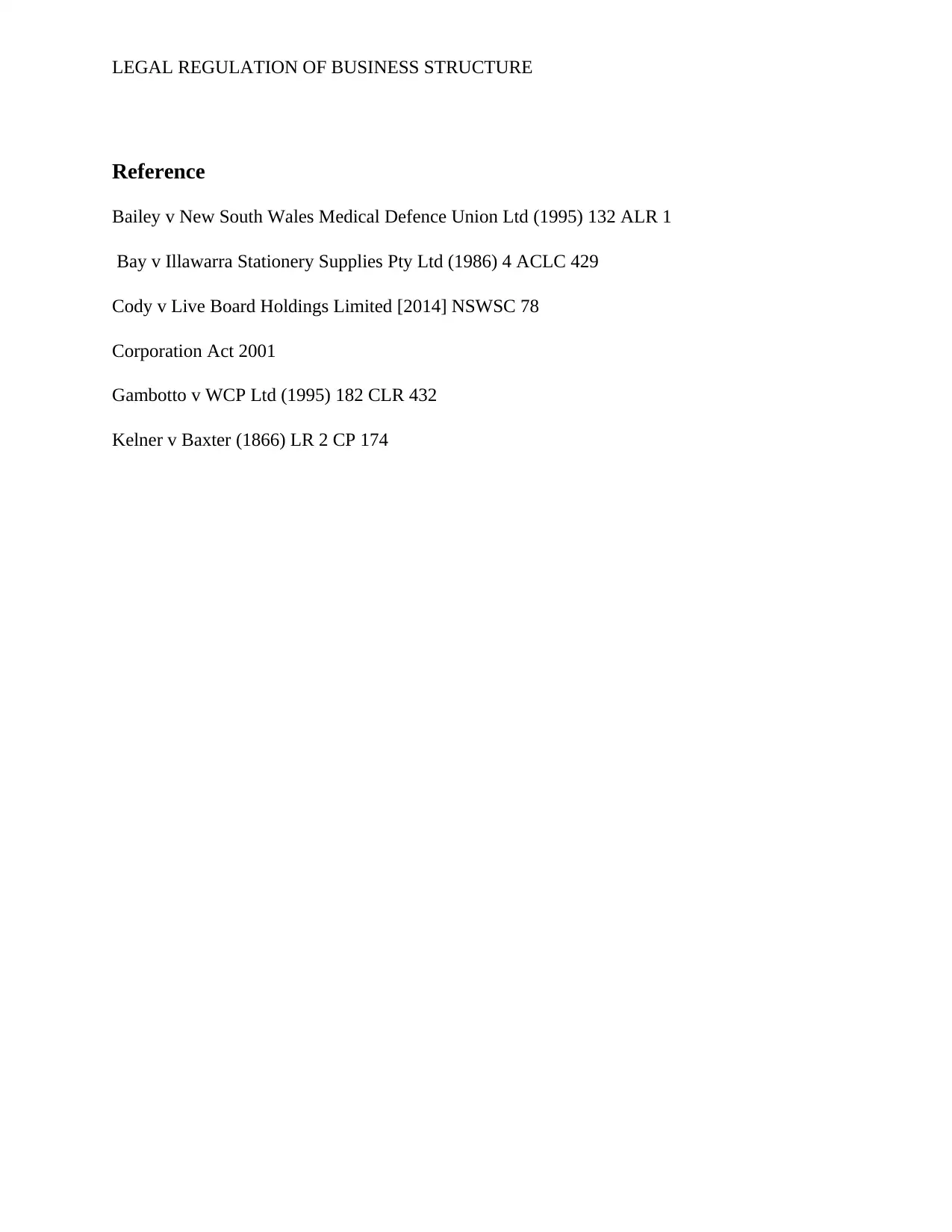
LEGAL REGULATION OF BUSINESS STRUCTURE
Reference
Bailey v New South Wales Medical Defence Union Ltd (1995) 132 ALR 1
Bay v Illawarra Stationery Supplies Pty Ltd (1986) 4 ACLC 429
Cody v Live Board Holdings Limited [2014] NSWSC 78
Corporation Act 2001
Gambotto v WCP Ltd (1995) 182 CLR 432
Kelner v Baxter (1866) LR 2 CP 174
Reference
Bailey v New South Wales Medical Defence Union Ltd (1995) 132 ALR 1
Bay v Illawarra Stationery Supplies Pty Ltd (1986) 4 ACLC 429
Cody v Live Board Holdings Limited [2014] NSWSC 78
Corporation Act 2001
Gambotto v WCP Ltd (1995) 182 CLR 432
Kelner v Baxter (1866) LR 2 CP 174
1 out of 10
Related Documents
Your All-in-One AI-Powered Toolkit for Academic Success.
+13062052269
info@desklib.com
Available 24*7 on WhatsApp / Email
![[object Object]](/_next/static/media/star-bottom.7253800d.svg)
Unlock your academic potential
© 2024 | Zucol Services PVT LTD | All rights reserved.



